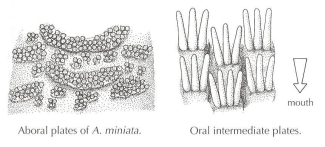Asterina miniata is a broad-armed sea star found in large numbers in shallow, sheltered waters on the west coast of Vancouver Island, the north coast of British Columbia, and the Queen Charlotte Islands. Its colour is extremely variable, and can be mottled or uniform red, yellow, brown, green and blue. The five arms (occasionally six) are up to 9 em long, and it has an arm-to-disc ratio of 1.6 to 2. The aboral plates along the radii of each arm are low and crescent-shaped with their concave side towards the centre. Smaller irregular plates are topped with a circle of granules. A row of tiny inferomarginals form the sharp edge between the aboral and oral sides. Immediately above them is a row of even smaller, round superomarginals. The oral interradial area is relatively flat from the mouth to the edge of the disc. Oral intermediates form a V-shaped pattern with the apex towards the mouth. Each plate has a webbed comb of 3 to 5 flat spines pointing away from the mouth that get smaller distally. The adambulacral plates have 2 to 4 furrow spines and an oblique row of 2 or 3 similar-sized spines on the oral surface. The mouth plates have 5 marginal spines and 2 or 3 heavier scoop-shaped suborals.
Characteristics
Similar SpeciesA. miniata has a similar shape to Dermasterias imbricata, but it feels like sandpaper rather than smooth and slippery.
